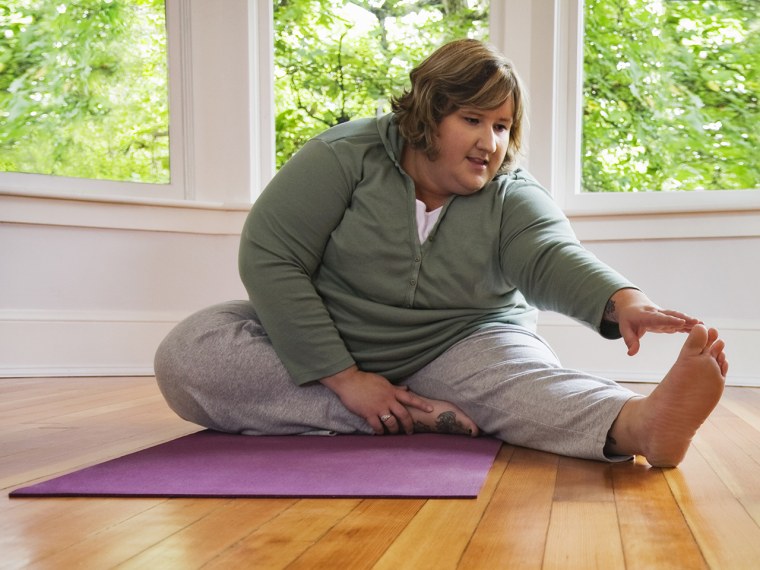Yoga is a weapon in the war on obesity, but it's also a fast-growing, $10 billion business. As its popularity expands in tandem with our collective waistline, analysts say there's a potentially lucrative market for clothing companies to outfit curvier bodies.
In a country where roughly two-thirds of adults are overweight or obese, medical experts and a growing community of health bloggers are suggesting that the answer might lie on a yoga mat. The number of yoga practitioners, which skews more than 80 percent female, jumped 29 percent in the past four years, according to a Yoga Journal study. It's become so mainstream that the White House even added yoga classes to its annual Easter egg roll last month.
“There’s a huge target market” for plus-size activewear, said Jaime Katz, an analyst at Morningstar. “It’s significant and it shouldn’t really be ignored because it’s getting bigger as a percentage of the total population.”
More From Today: Where to Shop for Cute and Cheap Plus Size Clothing
Yoga Journal found that spending on classes, clothes and other items grew from $5.7 billion in 2008 to $10.3 billion last year. Research company IBISWorld estimates that consumers will spend $332 million on fitness apparel sold in specialty plus-size women’s clothing stores this year — which doesn't include purchases of plus-size clothes at brands that also sell standard sizes, like Gap Inc.'s Athleta brand.
Analysts say it’s short-sighted for clothing companies to accept the stereotype that overweight people aren’t interested in fitness or exercise. A 2010 Gallup poll found that 53 percent of overweight people and 41 percent of obese people say these exercise three or more days per week.
“I think there is something that can be found there... for people who want to be healthier,” Katz said.
Despite the number of overweight people in the United States, though, plus-sized clothing in general has been what Alison Jatlow Levy, a retail strategist at consulting firm Kurt Salmon, calls an “underserved” market. When it comes to stretchy tank tops and yoga pants, that’s even more the case, she said. “Historically, that’s not where activewear has focused,” she said.
It’s a chicken-or-egg conundrum for both brands and customers. Manufacturers don’t want to make a big bet on an unproven market, especially because are production challenges and higher costs that come with making larger sizes.
But overweight women do want to be active — they just don’t have anything to wear, according to Deborah Christel, an assistant professor of design and merchandising at West Virginia University who wrote her doctoral dissertation on the women’s plus-size athletic clothing market.
"There’s no clothing available for their figure they feel comfortable in,” she said. “I think plus size women aren’t engaging in exercise or going to the yoga studio because they don’t have the right clothes.”
Athleta was a 10-year-old company when it was bought by Gap Inc. in 2008. At first an online-only outlet, Gap began opening Athleta brick-and-mortar stores two years ago — often within close proximity to stores of its top competitor, Lululemon Athletica. Although a small part of Gap’s empire, its size belies its potential impact on customer loyalty and sales, analysts say.
Selling yoga wear in larger sizes can generate repeat business, if larger customers subsequently lose weight, as well as customer loyalty that might cross over to its growing stable of other brands. On its investor conference call in February, CEO Glenn Murphy indicated that Athleta was a gateway brand. “We're bringing new customers into the Gap Inc. portfolio and family of brands with Athleta,” he said.
The Athleta brand includes yoga clothing in sizes up to 20. By contrast, Lululemon’s sizes top out at 12.
“I think Lululemon needs to be concerned about Athleta,” said Jahnia Sandford, an analyst at Kantar Retail. “Activewear and yogawear is definitely an area for growth,” she said. Offering larger sizes show that a brand is “catering to that shopper’s specific needs and making it known you have these specific styles available to her."
Lululemon already faced a heightened threat from Athleta because of a manufacturing defect that affected 17 percent of its black bottoms. The pants, which cost roughly $100, were too sheer when customers put them on.
“The lack of Lulu's core product in its stores and online could drive some customers to try competing brands,” CLSA analyst Barbara Wyckoff warned in a recent research note.
“Recent quality blunders and poor performance of new capsule collections have affected the company’s earnings results and hurt LULU’s brand equity,” she said.
Although Athleta is considered Lululemon’s biggest competitor, there are a growing number of other brands where consumers can buy larger yoga gear. Gap’s Old Navy brand, for instance, sells moisture-wicking tank tops and stretchy yoga pants up through size 30. Nordstrom’s Zella brand offers some styles through size 24. Specialty plus-size stores Lane Bryant and Avenue also cater to the downward-dog crowd, along with boutique brands bolstered by word-of-mouth endorsements in the blogosphere.
“I think it’s happening and it’s a trend but it will happen slowly and it’s still new,” Levy said.
